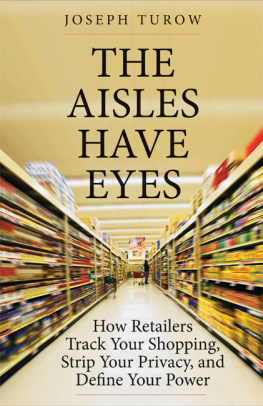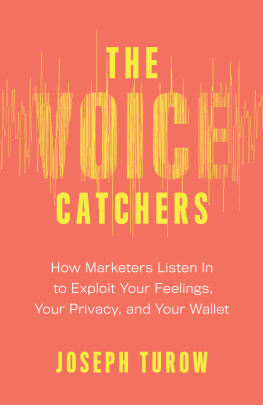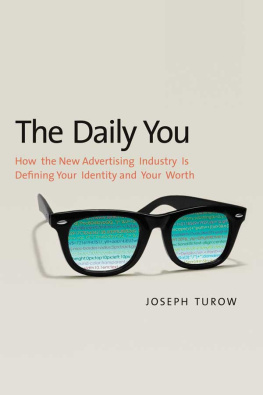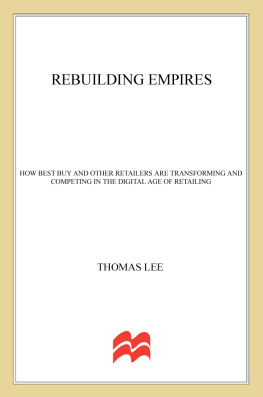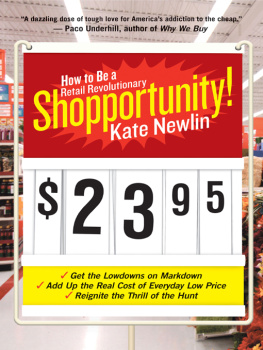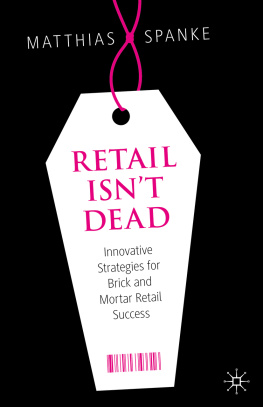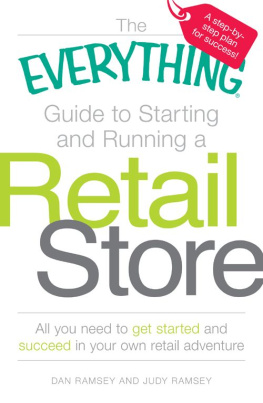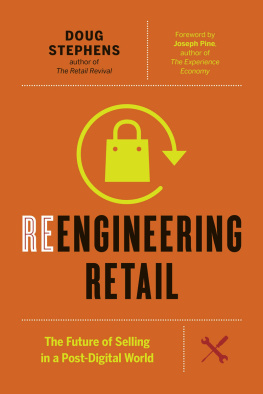THE AISLES HAVE EYES

Published with assistance from the foundation established in memory of Calvin Chapin of the Class of 1788, Yale College.
Copyright 2017 by Joseph Turow.
All rights reserved.
This book may not be reproduced, in whole or in part, including illustrations, in any form (beyond that copying permitted by Sections 107 and 108 of the U.S. Copyright Law and except by reviewers for the public press), without written permission from the publishers.
Yale University Press books may be purchased in quantity for educational, business, or promotional use. For information, please e-mail (U.K. office).
Set in Meridien and Futura type by IDS Infotech, Ltd.
Printed in the United States of America.
Library of Congress Control Number: 2016947155
ISBN 978-0-300-21219-8 (cloth : alk. paper)
A catalogue record for this book is available from the British Library.
This paper meets the requirements of ANSI/NISO Z39.48-1992 (Permanence of Paper).
10 9 8 7 6 5 4 3 2 1
For Judy
CONTENTS
THE AISLES HAVE EYES
A FROG SLOWLY BOILED
Its said that a frog placed in a boiling pot of water will escape, but if the water is slowly heated the frog will habituate and eventually die. Although scientists dispute the accuracy of this statement, no one in the audience of marketers objectedor even said it was ethically inappropriatewhen a digital-advertising executive used the image in an off-the-cuff suggestion of how marketers ought to treat people in physical stores. The occasion was a conference called The Internet of Things: Shopping that the online trade journal MediaPost convened in Manhattan during August 2015. The speaker, vice president of one of the worlds largest interactive agencies, wasnt invoking the frog image because he wanted to kill shoppers; he was addressing the concern that people would push back against beacon surveillance. Department stores, supermarkets, pharmacies, discount chains, and other retailers have among them already placed hundreds of thousands of these inexpensive devices throughout their stores.beacons proximity. We need to do a lot of hand-holding with our customers in the new environment, he urged. The goal had to be to treat shoppers like a frog in a pot of boiling water: they had to be introduced to all the changes slowly so that they would come to consider them as a normal part of their lives.
Brandon Fischer, director of predictive insights at the influential GroupM Next consultancy, offered a view of the in-store surveillance future that seemed to embrace the frog comparison. In a keynote talk at the meeting, he predicted that by 2028 half of Americans (and by 2054 nearly all Americans) will carry in their bodies device implants that communicate with retailers as they walk down the aisles and inspect various items. Based on how long you hold an item the retailers computers will tell whether or not you like it. Other signals from the implant will indicate whether you are nervous or cautious when you look at the price of the product you are holding. The analysis may lead, Fischer suggested, to a conclusion that a discount on the product may reduce your nervousness and lead you to purchase it. His argument was a blunt, optimistic case for biometric monitoring in stores. And just as with the frog-invoking executive, no one in the room protested. No one wondered, either, whether in just thirteen years people would realistically consider this activity natural.
The attendees nonchalance might seem strange, but the retailing business was changing so drastically and confusingly that such statements may well have seemed plausible. The message the marketers were hearing at the meeting and throughout their industry was that retailing is entering a new, hypercompetitive era with internet sellers. Brick-and-mortar merchantsthe department stores, supermarkets, specialty stores, and chain stores that are still the center of the retailing universewill succeed only if they figure out how to trace, quantify, profile, and discriminate among shoppers as never before. But for stores to survive this transition, shoppers will have to slowly learn to accept, even welcome, those eyes in the aisles as part of their natural environmentsort of like the frog in the pot of water.
This book is about how and why all of that is taking place, and the impact it is having on individuals as well as on society at large. Ill show how a new generation of merchantsWalmart, Target, Macys, Stop & Shop, Safeway, Lord & Taylor, and many moreis working with a set of technology organizations to build a new future for physical retailing. They are reorganizing shopping to capture data about us through the very media we carry, even wear (such as a Fitbit). The goal is to routinely track us, store information about what we buy and when, and score us based on that and other information. Different forms of these activities are already under way in many stores. Retailers are using increasingly sophisticated electronic monitors, which show up first as experiments and then become ordinary elements of shopping. We typically feel their presence through personalized discounts often linked to our rewards cards. Depending on who you are and where you shop, you may already have experienced early versions of the following situationsscenarios some shoppers would consider wonderful:
As you walk into an upscale department store, you may or may not realize that your phone signaled your arrival. The store cares because you belong to its loyalty program and have achieved high-value-customer status. Your presence is indicated to a store representative, whose tablet calls up your photo so she can recognize and greet you. The tablet also reveals which clothes you looked at on the stores website during the past week as well as the clothes you clicked on when you accessed the stores ads while visiting other websites during that period. Based on previous purchases and the information it has concerning your age, income, occupation, and family status, the stores computer predicts which of those garments you will buy. It also suggests matching accessories, again based on your website visits, previous purchases, and the special predictive sauce that mixes these behaviors with demographic information. When you complete your shopping and go to pay, you are pleasantly surprised to find that the computer is rewarding your loyalty in the form of a 20 percent discount on your purchases that day.
You enter your local supermarket, with the stores app on your smartphone. The app instantly springs to life as you walk toward the first aisle. It retrieves your shopping history and loyalty score from the firms computers and links them to the shopping list and Web coupons you had loaded on the app at home. The computer analyzes this information and concludes that this is a stocking-up visit rather than a drop-in for only a few items. Complex personalization formulas, which evaluate your shopping list and your location in the store, present you with ideas about what to buy, recipes based on whats in your cart, and discounts. The formulas also factor in information the supermarket has bought from data firms about your socioeconomic status, and assessments on where you are on various product buying cycles. Do your purchase patterns suggest you are at moderate risk for switching away from a particular shampoo? Does your increasingly less frequent purchase of a specific brand of diapers suggest a situation that can be countered with a $2 coupon (through a deal with the manufacturer), or is it likely your child is now potty-trained and so no longer needs them? Based on your shopping history, the formulas predict the extent of discounts that are needed to make you feel good about your shopping experience while also getting you to spend at least 10 percent more than you did the last time you came in to stock up.
Next page
